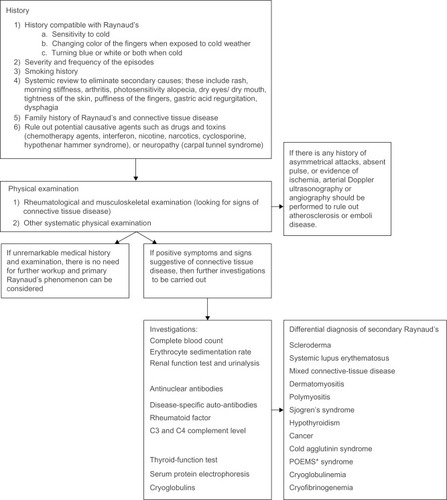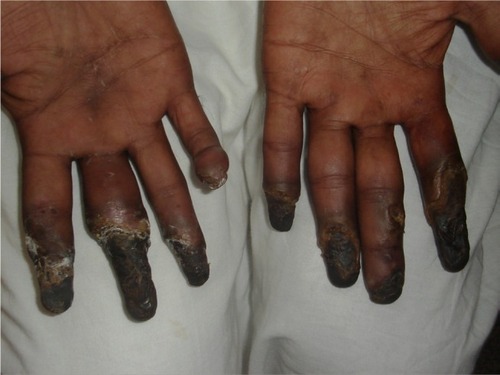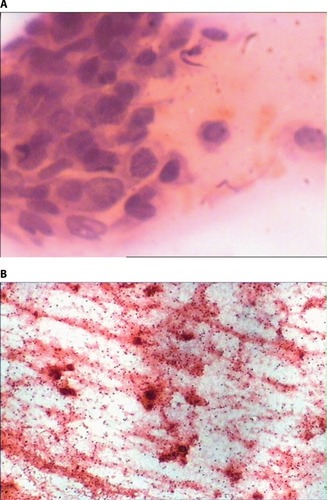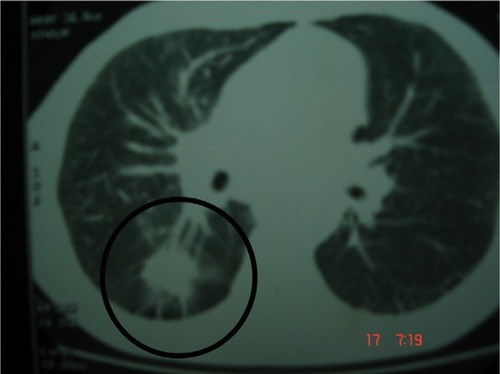Abstract
Background
Digital necrosis is a rare phenomenon of paraneoplastic syndrome associated with squamous cell carcinoma of the tonsil. Since 1965, more than 70 cases have been reported worldwide in the literature.
Case report
A 54-year-old male smoker presented with Raynaud’s phenomenon, proceeding to frank gangrene of the fingers. Working up the case finally pointed toward carcinoma of the tonsil as the underlying cause – a rare paraneoplastic manifestation.
Conclusion
No definite etiology has been found to be the cause of Raynaud’s phenomenon in this case of the squamous cell carcinoma of the tonsil. A brief discussion of the literature is also presented.
Case presentation
A 54-year-old male smoker (20 pack-years) presented with bluish discoloration of the fingers of both hands, associated with pain of 1 month’s duration. He also had halitosis at the time of presentation. Examination showed a firm 2–3 cm jugulodigastric node on the right side and an enlarged ulcerated right tonsil. Distal pulses, including the radial and dorsalis pedis, were normal. The patient was not taking any medication, and the family history was unremarkable. Clinically, acrocyanosis was a possibility, and so the causes were searched for. Fine-needle aspiration cytology from the node and a biopsy from the tonsil were arranged. Meanwhile, ischemic symptoms in the hand progressed and developed into frank gangrene and necrosis. By this time the node had increased in size and developed into a fungating growth ( and ).
The diagnostic investigations (ie, laboratory, radiology, etc) have been summarized in – and .
Figure 3 Diagnostic flowchart for Raynaud’s Phenomenon.

Table 1 Routine blood investigations
Table 2 Immunology screening
Table 3 Immunoglobulin screening
Table 4 Virology screening
Table 5 Other tests
Table 6 Imaging studies
A bronchoscopy was carried out and showed nonspecific inflammatory cells. The biopsy from the tonsil showed squamous cell carcinoma of the spindle cell variety. Fine needle aspiration cytology and the impression smear showed metastasis from the squamous cell carcinoma (). Radiological evidence of metastasis in the lungs shown in . The present case report was approved by Mubarak Al-Kabeer Hospital ethical board. Verbal informed consent was obtained from the patient for publication of this case report and accompanying images.
Discussion
Acronecrosis is a rare manifestation of malignant neoplasms such as neoplasm of the gastrointestinal tract, lung, and breast; ovarian and uterine carcinomas; renal adenocarcinoma; multiple myeloma; leukemia; and Hodgkin lymphoma, with the underlying mechanism still not being fully understood.Citation1–Citation4 The clinical presentation can range from splinter hemorrhages with pulp atrophy to digital necrosis. Raynaud’s syndrome is unlikely in our patient, because the presentation was rapidly progressive over a short period of time and with no aggravating factors. Raynaud’s syndrome, however, has been reported as an initial manifestation of an ovarian carcinoma.Citation5 Over the last 45 years, more than 70 casesCitation6 have been reported in the medical literature worldwide, describing the association of digital necrosis with different types of malignant neoplasms.Citation7
The suggested possible underlying mechanisms of the digital ischemia include arterial vasospasm mediated by immune complexes, blood hypercoagulability secondary to vascular occlusions, cryoglobulinemia, and necrotizing vasculitis. In our patient, cryoglobulins and immune complexes were not detected, and the thrombophilia screen was negative. Since the Doppler study of the hand was normal, there was unlikely to be a significant proximal (large) vessel component.
There is one reported case of digital necrosis resulting from squamous cell carcinoma of the tonsil in 2002;Citation8 therefore, it could be inferred that squamous cell carcinoma of the upper aerodigestive tract could be associated with acronecrosis.
The size of the primary tumor reduced following radiotherapy. The radiotherapy regimen given to the patient included intensity-modulated radiotherapy and weekly cisplatin (50 mg/m2). The hand function failed to show any improvement, and the patient eventually succumbed to the advanced disease.
Conclusion
To date, acronecrosis as a paraneoplastic manifestation has been rarely reported. We report this case so as to highlight the association of acronecrosis as a paraneoplastic manifestation of a squamous cell carcinoma of the tonsil.
Disclosure
The authors report no conflicts of interest in this work.
References
- PetrieMFyeHDigital necrosis: a paraneoplastic syndromeJ Rheumatol1985128008024057205
- TaillanBCastanetJGarnierGParaneoplastic Raynaud’s phenomenonClin Rheumatol19931222812828358996
- IamandiCDietemannAGrosshansEPauliGQuoixEParaneoplastic digital necrosis in a patient with small-cell lung cancerJ Clin Oncol200220234600460112454120
- ChowSFMcKennaCHOvarian cancer and gangrene of the digits: case report and review of the literatureMayo Clin Proc19967132532588594283
- KohliMBennettRMRaynaud’s phenomenon as a presenting sign of ovarian adenocarcinomaJ Rheumatol199522139313947562782
- WigleyFMHerrickAFlavahanNRaynaud’s Phenomenon – A Guide to Pathogenesis and TreatmentNew York, NYSpringer Science + Business Media, LLC2015141162
- HawleyPRJohnstonAWRankinJTAssociation between digital ischemia and malignant diseasesBr Med J19672232082126028467
- WrightJRGudelisSDigital necrosis associated with squamous cell carcinoma of the tonsilHead Neck200224111019102112410538




